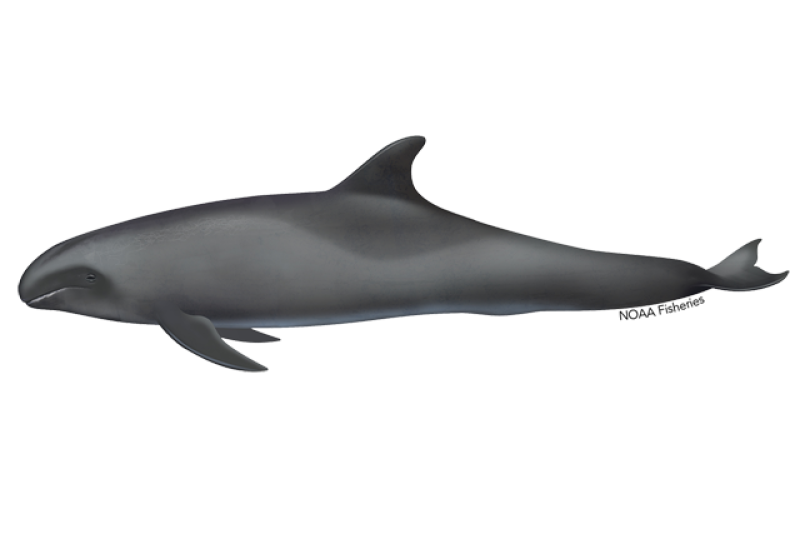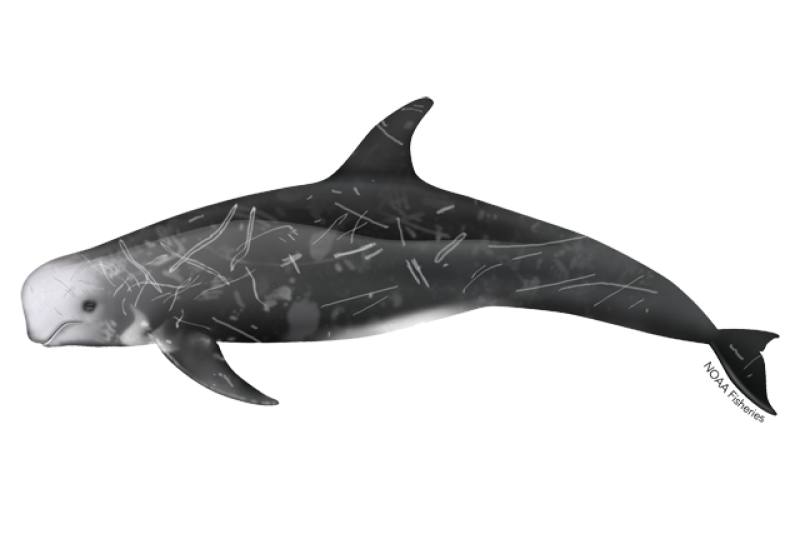Fraser's Dolphin
Lagenodelphis hosei
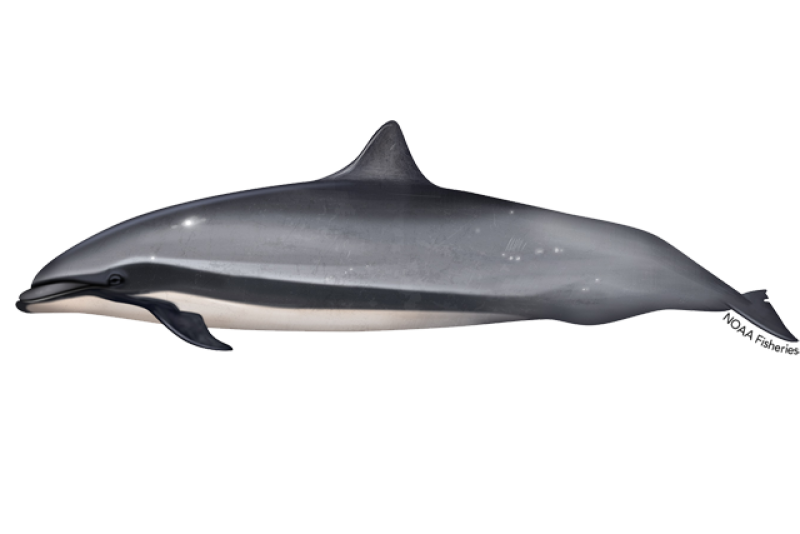
Protected Status
Quick Facts
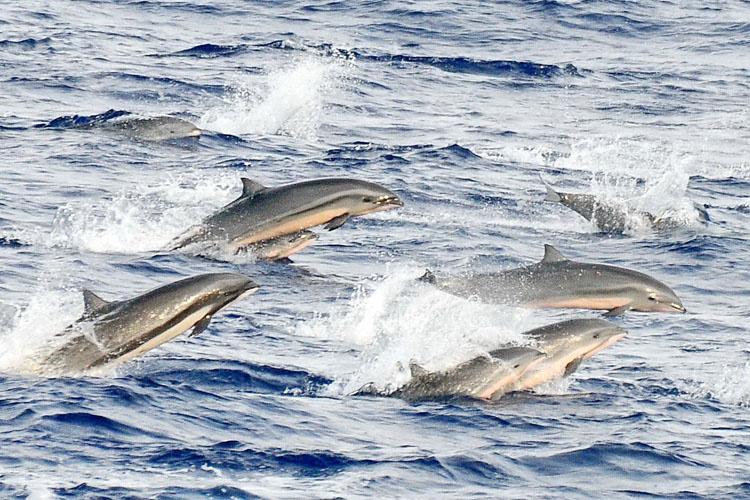 Fraser's dolphins. Credit: NOAA Fisheries
Fraser's dolphins. Credit: NOAA Fisheries
Fraser's dolphins. Credit: NOAA Fisheries
About the Species
 Fraser's dolphins. Credit: NOAA Fisheries
Fraser's dolphins. Credit: NOAA Fisheries
Fraser's dolphins. Credit: NOAA Fisheries
Fraser's dolphins are found in deep, tropical waters worldwide. They are active swimmers and are usually found in groups of 10 to 100 individuals, but they sometimes travel in groups of up to 1,000.
Francis Fraser, a scientist from the British Museum, first described this species in 1956 based on a skull found on a beach in Borneo. It was not until 1971, however, that scientists first documented Fraser’s dolphins in the wild.
Fraser’s dolphins, like all marine mammals, are protected under the Marine Mammal Protection Act (MMPA). NOAA Fisheries and its partners are working to conserve Fraser’s dolphins and further our understanding of this species through research and conservation activities.
Population Status
NOAA Fisheries estimates population size in its stock assessment reports.
While the worldwide population of Fraser's dolphins is unknown, scientists estimate that at least 100,000 to 289,000 Fraser’s dolphins live in the eastern tropical Pacific Ocean.
To manage Fraser's dolphins in U.S. waters, we have divided them into three stocks:
- Hawaiian stock
- Northern Gulf of America* (formerly Gulf of Mexico) stock
- Western North Atlantic stock
Our scientists estimate that there are about 10,000 Fraser's dolphins in the Hawaiian stock and 213 in the Gulf of America stock. The number of Fraser's dolphins in the western North Atlantic stock is unknown.
Appearance
Fraser’s dolphins have a stocky body with a small, distinct rostrum. Their dorsal fin—located midway down their back—is small and triangular. Their flippers and flukes are smaller than those of other dolphin species. Males are slightly longer and heavier than females, with a more distinct color pattern.
All Fraser's dolphins have a dark stripe that extends down their side from eye to pectoral flipper. The exact shape of the stripe varies based on geography and sex, with males tending to have a thicker, darker stripe than females. Their upper body is bluish or brownish-gray, while their underside is usually pale white or pink. Calves are usually less colorful than adults.
Behavior and Diet
Fraser's dolphins are usually found in large, tight groups of 10 to 100 individuals, but they have sometimes been seen in groups of up to 1,000 individuals. Groups of individuals sometimes swim in long "chorus line” formations. They are also sometimes seen in mixed groups with other cetacean species such as false killer whales, melon-headed whales, Risso's dolphins, and short-finned pilot whales.
Fraser's dolphins in some parts of the world are cryptic and hard to find, making observations of this species rare. In other areas, this species may be less cryptic and may be curious around vessels.
Fraser's dolphins can dive up to 2,000 feet to feed on deep-sea fish, crustaceans (such as shrimp), and cephalopods (such as squid and octopus). They have 20 to 44 pairs of small, cone-shaped teeth to help them catch prey. Dolphins do not use their teeth to chew their prey, instead once the prey are caught, they are swallowed whole.
Where They Live
Fraser's dolphins are found in warm, temperate, subtropical, and tropical waters around the world. They prefer to live in areas with deep waters (3,300 feet deep) and are often found in areas of upwelling (where cold, nutrient-rich water rises toward the surface). They also live near coastlines or where the continental shelf (the edge of a continent below the ocean’s surface) is narrow, usually in locations with mountainous coasts.
Stranded Fraser's dolphins have sometimes been reported in places outside of their typical range, such as southern Australia, France, western Scotland, and Uruguay.
Lifespan & Reproduction
Fraser’s dolphins live about 18 years and become sexually mature when they are 5 to 10 years old (females at 5 to 8 years, males at 7 to 10 years). Gestation lasts for about 10 to 12.5 months and females give birth to a single calf every 2 years, usually between spring and autumn.
Threats
Interactions with Fishing Gear
One of the main threats to Fraser’s dolphins is getting caught in fishing gear. This species can become entangled or captured in commercial fishing gear, such as gillnets, seines, trawls, trap pots, and longlines. Specifically, they have been caught in tuna purse seine fisheries in the eastern tropical Pacific and the Philippines. These interactions can injure Fraser's dolphins or kill them by entanglement in the gear.
Hunting
Fisheries in Indonesia, Japan, the Lesser Antilles, the Philippines, and Sri Lanka hunt and kill Fraser’s dolphins for meat and oil.
*Executive Order 14172, “Restoring Names That Honor American Greatness” (Jan. 20, 2025), directs that the Gulf of Mexico be renamed the Gulf of America. Gulf of America references in this website refer to the same area as the Gulf of Mexico in the applicable regulations under 50 CFR parts 216–219, 222–226, and 600–699. The name change did not result in any changes to, and had no effect on the applicability or enforceability of, any existing regulations. This website continues to use “Gulf of Mexico” when quoting statutes, existing regulations, or previously published materials.
Scientific Classification
| Kingdom | Animalia | Phylum | Chordata | Class | Mammalia | Order | Cetacea | Family | Delphinidae | Genus | Lagenodelphis | Species | hosei |
|---|
Last updated by NOAA Fisheries on 04/24/2025
What We Do
Conservation & Management
NOAA Fisheries is committed to the protection of Fraser’s dolphins. Targeted management actions taken to secure protections for these dolphins include:
- Overseeing marine mammal health and stranding response
- Addressing ocean noise
- Educating the public about Fraser’s dolphins and the threats they face
Science
Our research projects have discovered new aspects of Fraser’s dolphin biology, behavior, and ecology and help us better understand the challenges that all Fraser’s dolphins face. Our work includes:
- Stock assessments
- Monitoring population abundance and distribution
How You Can Help
Keep Your Distance
Be responsible when viewing marine life in the wild. Observe all dolphins and porpoises from a safe distance of at least 50 yards and limit your time spent observing to 30 minutes or less.
Report Marine Life in Distress
Report a sick, injured, entangled, stranded, or dead animal to make sure professional responders and scientists know about it and can take appropriate action. Numerous organizations around the country are trained and ready to respond. Never approach or try to save an injured or entangled animal yourself—it can be dangerous to both the animal and you.
Learn who you should contact when you encounter a stranded or injured marine animal
Report a Violation
Call the NOAA Fisheries Enforcement Hotline at (800) 853-1964 to report a federal marine resource violation. This hotline is available 24 hours a day, 7 days a week for anyone in the United States.
You may also contact your closest NOAA Office of Law Enforcement field office during regular business hours.
Featured News
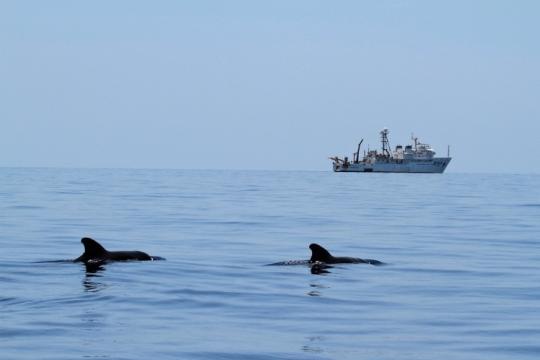 Pilot whales surface near the NOAA Ship Gordon Gunter. Credit: NOAA Fisheries/Melody Baran (Permit # 14450)
Pilot whales surface near the NOAA Ship Gordon Gunter. Credit: NOAA Fisheries/Melody Baran (Permit # 14450)
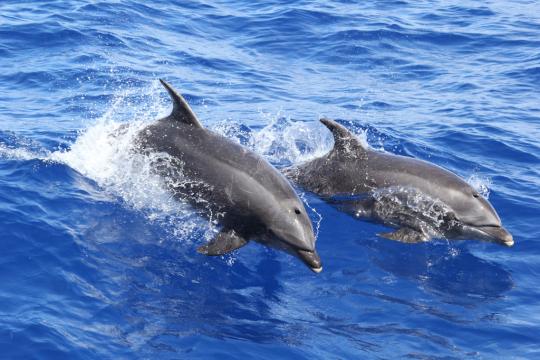 Pair of bottlenose dolphins. Credit: NOAA Pacific Islands Fisheries Science Center/Lisa Morse.
Pair of bottlenose dolphins. Credit: NOAA Pacific Islands Fisheries Science Center/Lisa Morse.
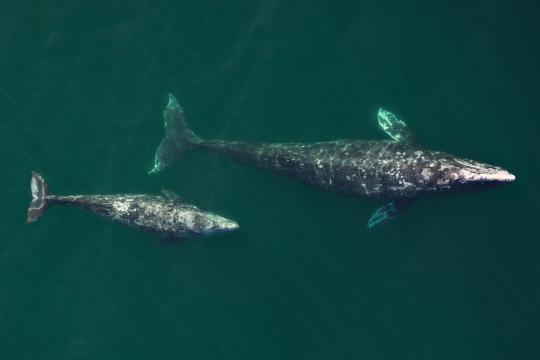 Gray whales were nearly hunted to extinction by commercial whaling. Protections under the MMPA, ESA, and the end of commercial whaling have allowed the species to recover. Credit: NOAA Fisheries (Permit #19091).
Gray whales were nearly hunted to extinction by commercial whaling. Protections under the MMPA, ESA, and the end of commercial whaling have allowed the species to recover. Credit: NOAA Fisheries (Permit #19091).
Celebrating 50 Years of the Marine Mammal Protection Act
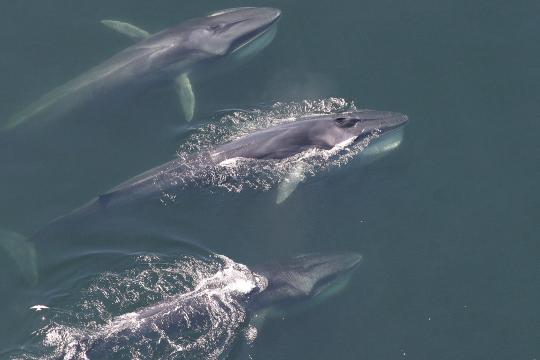 Finback whales. Credit: NOAA Fisheries
Finback whales. Credit: NOAA Fisheries
11 Cool Facts About Whales, Dolphins, and Porpoises
Management Overview
The Fraser’s dolphin is protected throughout its range under the Marine Mammal Protection Act.
Additionally, the Fraser’s dolphin is listed under:
- Appendix II of the Convention on International Trade in Endangered Species of Wild Fauna and Flora (CITES)
- Annex II of the Protocol for Specially Protected Areas and Wildlife (SPAW)

Conservation Efforts
Overseeing Marine Mammal Health and Stranding Response
We work with volunteer networks in all coastal states to respond to marine mammal strandings including all dolphins and porpoises. When stranded animals are found alive, NOAA Fisheries and our partners assess the animal’s health and determine the best course of action. When stranded animals are found dead, our scientists work to understand and investigate the cause of death. Although the cause often remains unknown, scientists can sometimes attribute strandings to disease, harmful algal blooms, vessel strikes, fishing gear entanglements, pollution exposure, and underwater noise. Some strandings can serve as indicators of ocean health, giving insight into larger environmental issues that may also have implications for human health and welfare.
Learn more about the Marine Mammal Health and Stranding Response Program
Marine Mammal Unusual Mortality Events
Fraser’s dolphins have never been part of a declared unusual mortality event. Under the Marine Mammal Protection Act, an unusual mortality event is defined as "a stranding that is unexpected; involves a significant die-off of any marine mammal population; and demands immediate response." To understand the health of marine mammal populations, scientists study unusual mortality events.
Get information on active and past UMEs
Get an overview of marine mammal UMEs
Addressing Ocean Noise
Underwater noise threatens Fraser's dolphin populations, interrupting their normal behavior and driving them away from areas important to their survival. Increasing evidence suggests that exposure to intense underwater sound in some settings may cause this species to strand and ultimately die. NOAA Fisheries is investigating all aspects of acoustic communication and hearing in marine animals, as well as the effects of sound on whale behavior and hearing. In 2016, we issued technical guidance for assessing the effects of anthropogenic (human-caused) sound on marine mammals’ hearing.
Educating the Public
NOAA Fisheries aims to increase public awareness and support for Fraser’s dolphin conservation through education, outreach, and public participation. We share information with the public about the status of Fraser’s dolphins, as well as our research and efforts to promote their recovery.
Regulatory History
Fraser’s dolphins, like all marine mammals, are protected in the United States under the MMPA.
Key Actions and Documents
Last updated by NOAA Fisheries on 04/24/2025
Science Overview
NOAA Fisheries conducts various research activities on the biology, behavior, and ecology of Fraser’s dolphins. The results of this research are used to inform management decisions for this species.
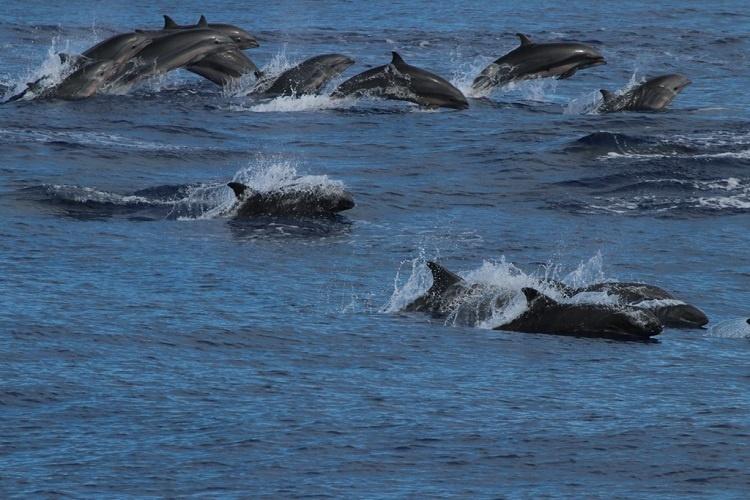
Stock Assessments
Determining the size of Fraser’s dolphin populations helps resource managers determine the success of conservation measures. Our scientists collect population information and present the data in annual stock assessment reports.
Monitoring Population Abundance and Distribution
Scientists observe Fraser’s dolphins to record their numbers and distribution. By comparing numbers collected over multiple years, scientists can look for trends—i.e., whether the population is increasing, decreasing, or remaining stable during a given period.
More Information
Last updated by NOAA Fisheries on 04/24/2025
Outreach & Education
Dolphin Friendly Fishing Tips Sign
This sign is often posted near boat ramps, piers, docks, marinas, and waterfront parks.
Protect Wild Dolphins Sign
This sign is often posted near boat ramps, piers, docks, marinas, and waterfront parks.
Don't Feed Wild Dolphin Sign
This sign is often posted near boat ramps, piers, docks, marinas, and waterfront parks.
Last updated by NOAA Fisheries on 04/24/2025

